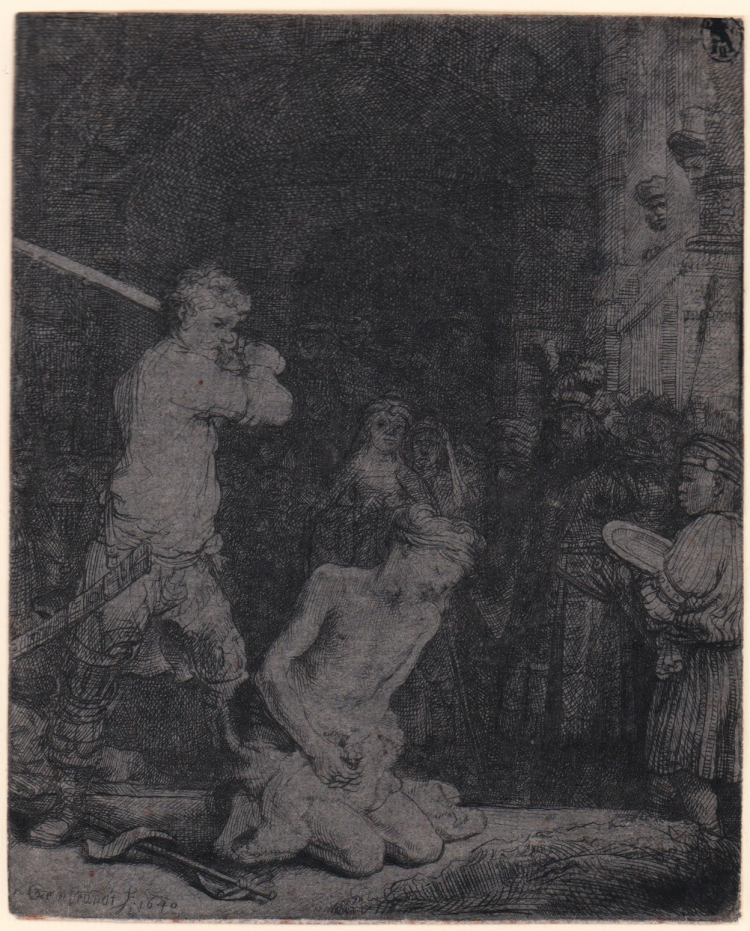



| Reference: | S40255 |
| Author | Harmensz van Rijn detto REMBRANDT |
| Year: | 1640 |
| Measures: | 103 x 129 mm |


| Reference: | S40255 |
| Author | Harmensz van Rijn detto REMBRANDT |
| Year: | 1640 |
| Measures: | 103 x 129 mm |
PRINTED ON BLUE PAPER
The beheading of St John the Baptist; soldier with sword poised, St John kneeling, with Salome amongst onlookers, including a black page with a salver; first state before reworking by another hand. 1640
Etching and drypoint, Lettered with Rembrandt's signature and date, in lower left: "Rembrandt f. 1640".
A fine example of the first state of two, printed on blue paper, trimmed to the platemark, generally in good condition.
Rembrandt's works printed on blue or Japanese paper are very rare on the market and in the Public Collections (cfr. Rembrandt’s Etchings and Japanese Echizen Paper, Rembrandt House
Museum, Amsterdam, 12 June — 20 September 2015).
Anthony Griffiths "Prints and Printmaking: An Introduction to the History and Techniques", Londra 1996, p. 35: "Although in the fifteenth cebturies illustrations in books had been occasionally printed on vellum or blue paper and a few single-sheet prints on silk, it was not until the seventeenth century that artists esplored this field with any enthusiasm. Hercules Segers led the way by sometimes printing on cloth, but the greatest figure was (again) Rembrandt, who experimented with vellum, a variety of imported yellowish Japanese paper, a thin 'Chinese' paper and a rought oatmeal paper".
Collector's mark at the upper right corner of Friedrich August II de Saxe (Lugt 971) and on verso (Lugt 780a).
|
New Hollstein (Dutch & Flemish) 183.I (Rembrandt); White & Boon 1969 92.I
|
Harmensz van Rijn detto REMBRANDT (Leida 1606 - Amsterdam 1669)
|
Born in Leiden, Holland in 1606, Rembrandt studied with Jacob Isaacsz van Swanenburgh (1571-1638) and Pieter Lastman (1583-1633). By 1626 he was an independent painter, working in Leiden alongside Jan Lievens (1607-74), another pupil of Lastman.
In 1631 Rembrandt moved to Amsterdam where he painted portraits of wealthy merchants. Three years later, he married his first wife, Saskia, and by the end of the 1630s he had moved into a substantial house (now the Rembrandt House Museum). In 1642, the year Rembrandt completed The Nightwatch (Rijksmuseum, Amsterdam), Saskia died.
By 1649, Hendrikje Stoffels had become his housekeeper and partner. Both Saskia and Hendrikje Stoffels posed for many paintings and sketches, often appearing as Susannah, Diana, Flora, Artemisa and other classical or Biblical figures. Rembrandt, however, was plagued by financial troubles and in 1656 his assets were made over to the courts, and many were sold. With his wife and son in financial control, Rembrandt continued to paint. Hendrikje died in 1663, his son Titus in 1668 and Rembrandt himself in 1669.
In his drawings, etchings and paintings, Rembrandt treated every subject: histories, landscapes, portraits, self-portraits, everyday scenes or sketches from nature. Rembrandt's biographer, Cornelis de Bie, praised his paintings, 'which enlighten every mind', and his etchings which are 'the very soul of life that lives therein'.
|
|
New Hollstein (Dutch & Flemish) 183.I (Rembrandt); White & Boon 1969 92.I
|
Harmensz van Rijn detto REMBRANDT (Leida 1606 - Amsterdam 1669)
|
Born in Leiden, Holland in 1606, Rembrandt studied with Jacob Isaacsz van Swanenburgh (1571-1638) and Pieter Lastman (1583-1633). By 1626 he was an independent painter, working in Leiden alongside Jan Lievens (1607-74), another pupil of Lastman.
In 1631 Rembrandt moved to Amsterdam where he painted portraits of wealthy merchants. Three years later, he married his first wife, Saskia, and by the end of the 1630s he had moved into a substantial house (now the Rembrandt House Museum). In 1642, the year Rembrandt completed The Nightwatch (Rijksmuseum, Amsterdam), Saskia died.
By 1649, Hendrikje Stoffels had become his housekeeper and partner. Both Saskia and Hendrikje Stoffels posed for many paintings and sketches, often appearing as Susannah, Diana, Flora, Artemisa and other classical or Biblical figures. Rembrandt, however, was plagued by financial troubles and in 1656 his assets were made over to the courts, and many were sold. With his wife and son in financial control, Rembrandt continued to paint. Hendrikje died in 1663, his son Titus in 1668 and Rembrandt himself in 1669.
In his drawings, etchings and paintings, Rembrandt treated every subject: histories, landscapes, portraits, self-portraits, everyday scenes or sketches from nature. Rembrandt's biographer, Cornelis de Bie, praised his paintings, 'which enlighten every mind', and his etchings which are 'the very soul of life that lives therein'.
|